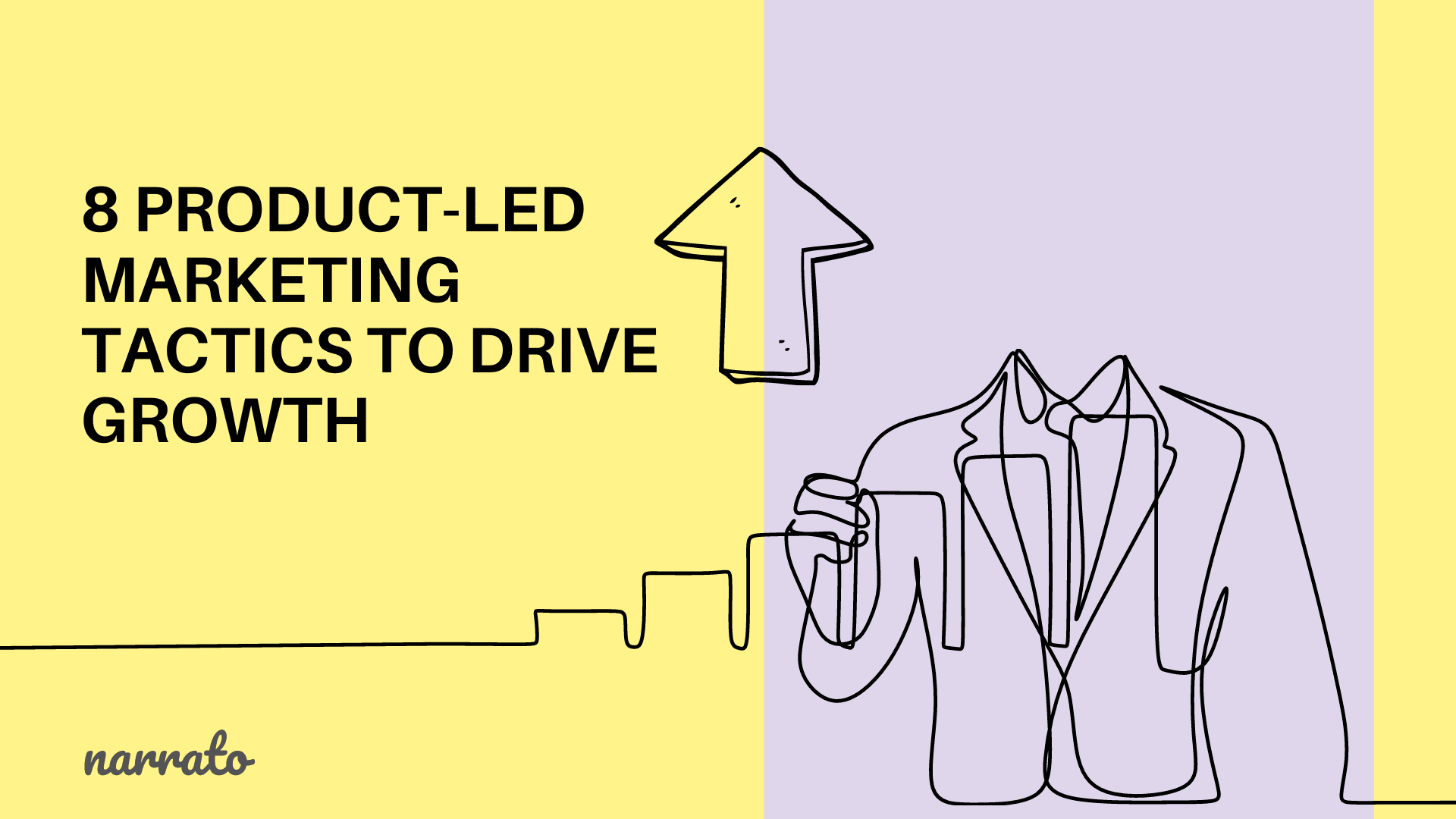Product-led marketing is quickly turning into a SaaS industry buzzword. But while many SaaS marketers know what is product led growth, the challenge arises in executing their PLG strategies. How do you ensure that product-led growth through marketing and content? How can you drive user engagement with product-led content? How do you plan product-led SEO? These concerns are real and valid.
But the good news is, product-led growth is not as complicated as it may seem. It is simply what the term suggests – putting the product at the forefront. Product-led marketing is about re-imagining ways to get more people to use the product. There are some tried and tested methods to ensure that your product-led growth marketing efforts lead prospects to the sign-up page and urge them to share the word. We’ll talk all about these product-led marketing tactics here.
– What is product-led growth marketing?
– Product-led marketing tactics to support your growth strategy
- Generate recommendations not just awareness of the product
- Create highly actionable resources
- Create content for every stage of a customer’s journey
- Focus on the shareability and virality of your content and product
- Give them visuals that are worthwhile
- Retain customers with onboarding emails and guides
- Freemium and free trial
- Offer incentives and referral points

What is product-led marketing?
Product-led marketing refers to marketing strategies that use the product itself to drive growth and acquire new customers. Along with valuable content, product-led growth marketing also implements other tactics to draw the reader’s attention to the product, get them to try it, and convince them to recommend it. In traditional content marketing, you would be wary of mentioning your product within your marketing content to avoid sounding self-promotional. But in product-led marketing, your product is the hero of your content – without sounding salesy.
A major difference between traditional marketing and product-led marketing is that the role of product-led marketing teams does not end at bringing leads into the funnel, leaving the rest to the sales team. In product-led marketing, they are also responsible for nurturing and retaining customers.
In product-led marketing –
- The product itself is the primary marketing tool
- Marketing teams don’t just stop at lead generation but also help sales teams with customer acquisition and retention
- A good understanding of the product and insights into product usage are crucial
- Content needs to be created for every stage of the sales funnel and beyond
- User experience and word-of-mouth play a key role
- You can save dollars on paid campaigns and still drive user acquisition
TL;DR here’s a quick video with the key takeaways from this post.
Product-led marketing tactics to support your growth strategy
Product-led marketing for SaaS evolved from the traditional ways with the understanding that customers today want to have more autonomy when it comes to making a purchase decision. Cold calling and emails from sales reps, or monotonous product demos are no longer effective. Buyers want to see for themselves if the product can solve the problems they are facing.
Even in product-led content marketing, the idea is not to go on and on about a product’s features but to highlight how these features can tackle the audience’s biggest challenges. There are several ways you can help your audience/ prospects discover your product’s true value through marketing and content.
Here are a few product-led marketing tactics that are sure to drive growth for your business.
1. Generate recommendations not just awareness of the product
The first and most important thing to remember when building a product-led content marketing strategy is that you are not just building awareness. You are rather ensuring that the reader finds enough value in the product to recommend it to others as well. Product-led growth requires prospects to use the product, realize its worth, and encourage more users to try it.
To make this happen, it is extremely important that product-led marketing teams thoroughly and deeply understand what the product can do. They have to be very clear about each ideal customer profile and how the product can help these customers solve different problems. Based on this knowledge, you can create tons of resources, guides, and tips to help people discover new features and product functionality. You can create multiple value propositions and show prospects what else they can do with your product.
This kind of product-led content combined with other product-led growth marketing tactics can surely improve user experiences and bring you more recommendations.
2. Create highly actionable resources
In traditional marketing, we talk about informing and educating our audience. We talk about creating content that is authoritative and enriched with facts and figures. Product-led content also focuses on providing value but in a different way. With helpful product-led content, the aim is not just to educate but drive action. This means you have to fill your content with actionable tips and solutions that the reader can implement using your product.
The question, though, is how to find out what your audience is looking for? What resources and solutions do they need? There are quite a few ways to approach this. The first thing that helps is your product-led SEO research. Before creating any content, you surely do some keyword research – this should also tell you what your audience is searching for. The easiest way is to generate an SEO content brief on Narrato. This SEO brief gives you keywords as well as questions people are asking related to your primary search term/topic or your product.
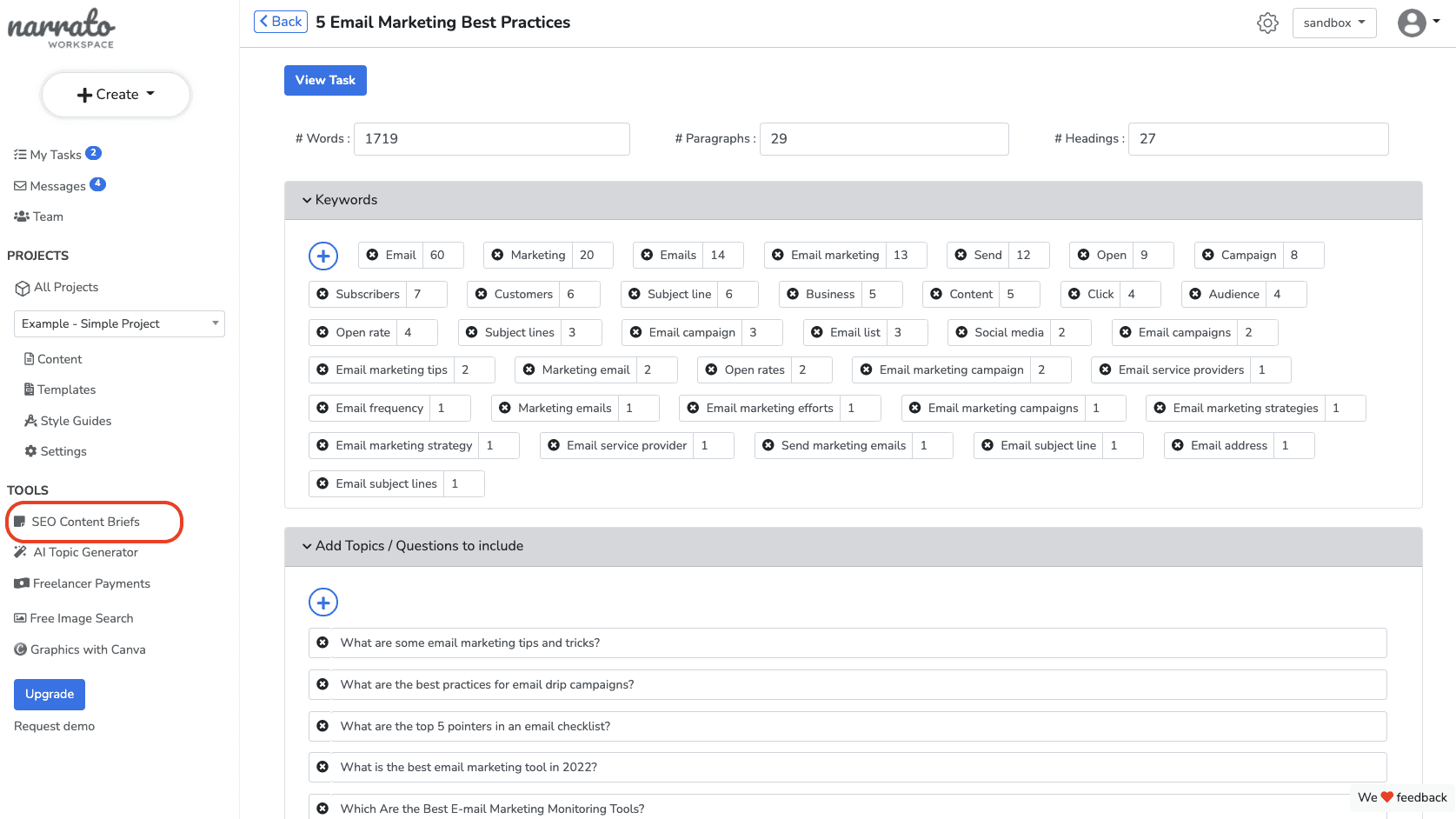
You can also refer to the ‘People also ask’ section in Google search for related search queries. Once you know what the relevant keywords and questions are, it becomes a lot easier to plan your actionable content around these.
3. Create content for every stage of a customer’s journey
While creating actionable content is the key, there are more considerations that you need to make here. Prospects at different stages of the funnel cannot be expected to take the same actions. For instance, someone who has just discovered your product cannot be expected to start using the advanced features right away. So if all you are offering is detailed guides on your most elaborate features, they might feel lost and overwhelmed. They may never even go on to try the product because it seems too complicated for them, also increasing your churn rates.
Similarly, someone who is at the bottom of the funnel, has already signed up for the free trial, and is ready to make a purchase does not need to know about your most basic features. If they’ve reached this far, they are aware of these capabilities by now. They need to know what more the product can offer that others don’t.
So creating content for different stages of a customer’s journey, keeping in mind their different needs is what good product-led content marketing is about. To get an idea about how different users are using the product, you can gather insights on product usage and behavioral data. There are several product analytics tools that tell how your users are working with the various features. You can also identify which features they are finding useful and where they might need more help, thus giving you ideas for content.
Another good way to go about this is coordinating with your customer success team and your sales team. They usually have a lot of customer data that includes user experience and product usage data as well. You could also run some surveys to find out how existing customers are using your product, to gather more specific insights.

4. Focus on the shareability and virality of your content and product
As we mentioned before, the whole purpose of product-led marketing is to get more people to use the product. This requires word-of-mouth marketing and extensive sharing by happy users, which acts as social proof. So making your content share-worthy and shareable should be another focal point in your strategy.
To make people want to share your content, you have to give them something that makes them go, “Oh, this is something we hadn’t thought about”. It could be a very unique problem the product solves or a template that they could use build a custom solution on your SaaS platform. If you’ve read our ClickUp content marketing case study or Airtable content marketing case study, you already know that most successful SaaS companies share tons of templates with their audience. Here’s an example from Hootsuite’s blog.
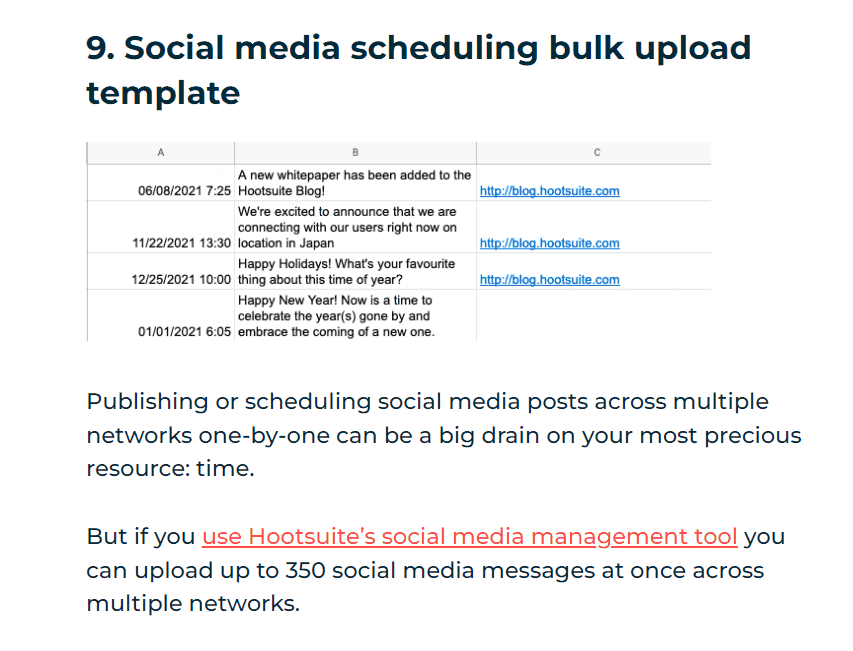
Offering free templates to your prospects encourages them to try the product. With a template, their job is made easier and if it is really good they may even share it with their colleagues and teams.
It also helps with product-led SEO as many people search for templates online and you could rank in these searches if you’re using the right keywords matching the search intent.
To increase your chances of getting shared and going viral, it is always best to add social sharing buttons to your blog posts and articles. The easier you make it, the more likely people are to share what they find helpful.
Another good way to increase shareability, and possibly virality, is allowing users to share their work on the platform through publicly shareable links, etc. For instance, if you’re creating a design on Canva, you can share your design with your team via a sharing link which when clicked takes them to the Canva task itself. Or if you are creating content on Narrato, you can share a public link to your content task with commenting, viewing, or editing access.
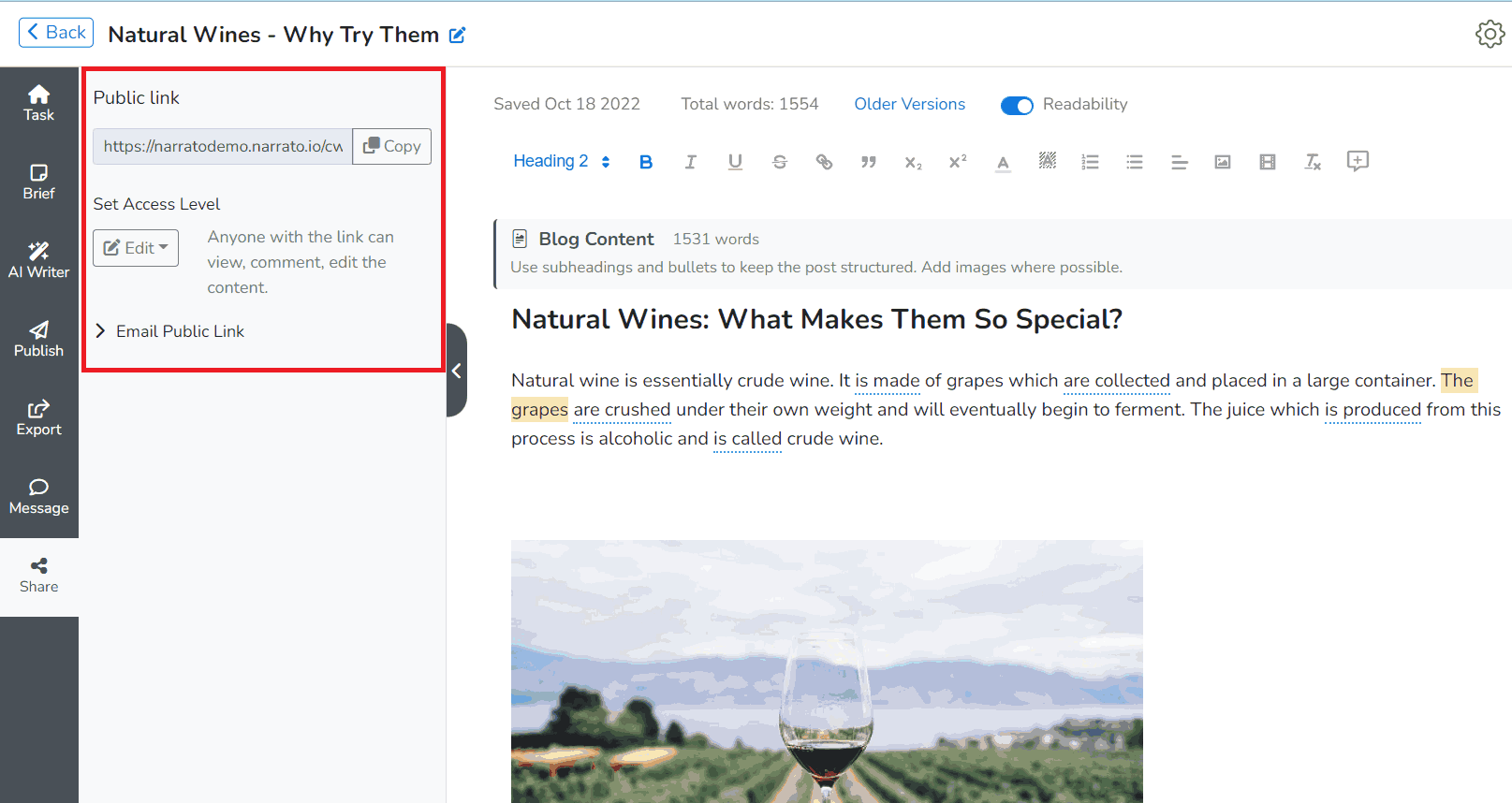
This will bring more eyeballs to the product as your user’s network also gets a taste of it. So the product itself drives its virality.
5. Give them visuals that are worthwhile
We all know visuals make your content more engaging and break the monotony of text. But instead of just adding random stock images or an infographic that does not really tell them about the product, why not show your product in action? If you’re creating product-led content, your product is the protagonist of the story and people need to see it.
Use lots of screenshots, GIFs, and videos of your product wherever you can. If you are talking about a feature, add a screenshot of how it looks on the platform and where they can find it. Use GIFs and videos to demonstrate product functionality.
In product-led content marketing, the idea is that if you are using visuals they should draw attention to the product and add value to the actionable resource.
6. Retain customers with onboarding emails and guides
While acquiring product qualified leads is one of the primary goals in product-led marketing, customer retention is also equally important. Because it is these customers that will bring in more leads through their recommendations if the experience is worth it. This is why product-led marketing teams also need a strategy of ongoing value addition for customers.
To ensure a great customer experience right from the start, it is important to provide them with all the resources you can to help them navigate their way around the product. It is a good idea to have some user onboarding emails ready to welcome them and get them started. You can create a series of emails to send out at different stages too. For this, you can create different email templates using the custom content templates on Narrato and save them in the Templates library. Here’s an example of an email newsletter template on Narrato.
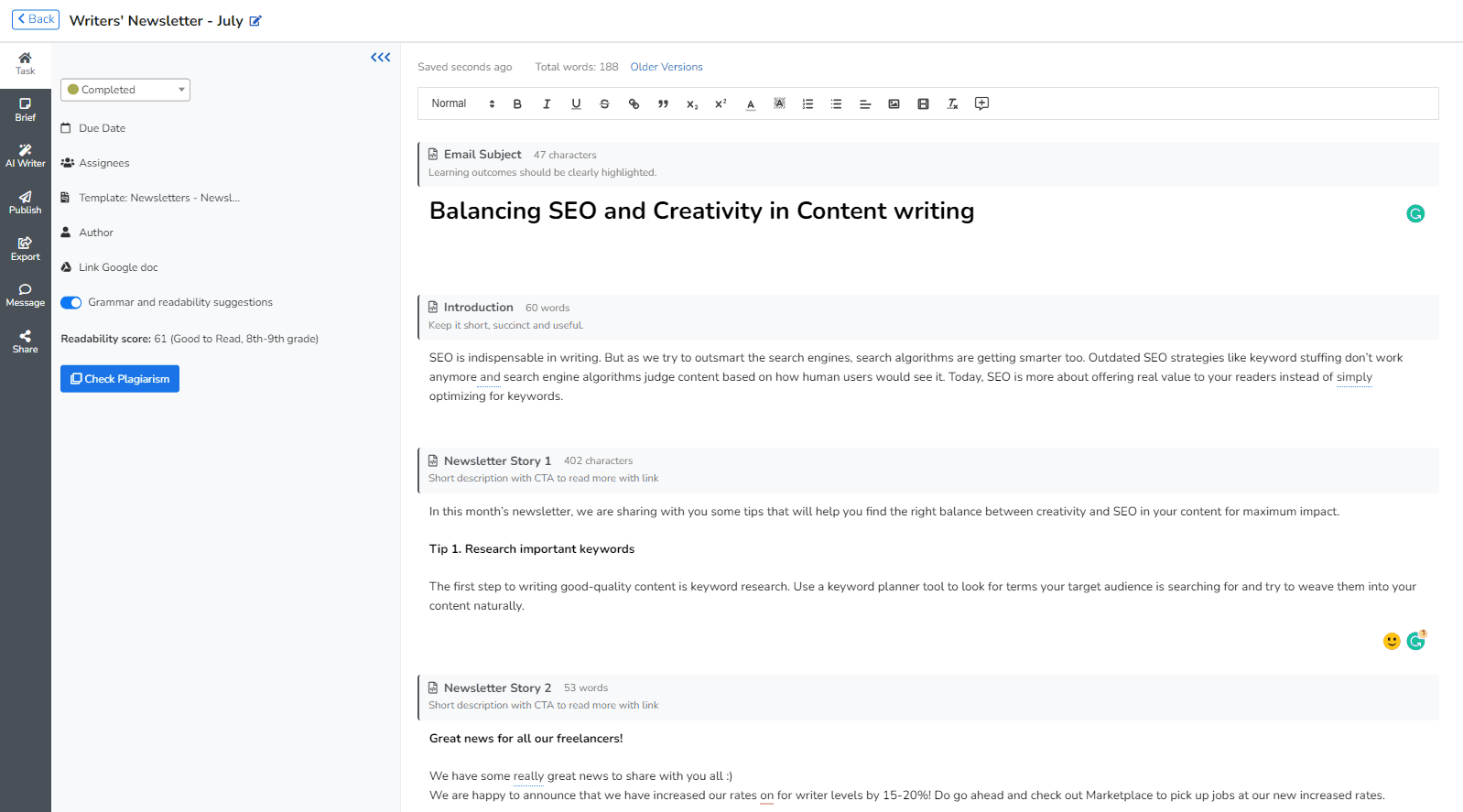
Apart from user onboarding emails, you can also create other resources such as user guides. In fact, your onboarding emails could lead users to these resources. Here’s an example from a SendPulse blog post. This onboarding email by Payoneer not only shares tips that would help a new user but also links to the more detailed guide on ‘click here’ and has a CTA button that takes the user to the platform to get it done.
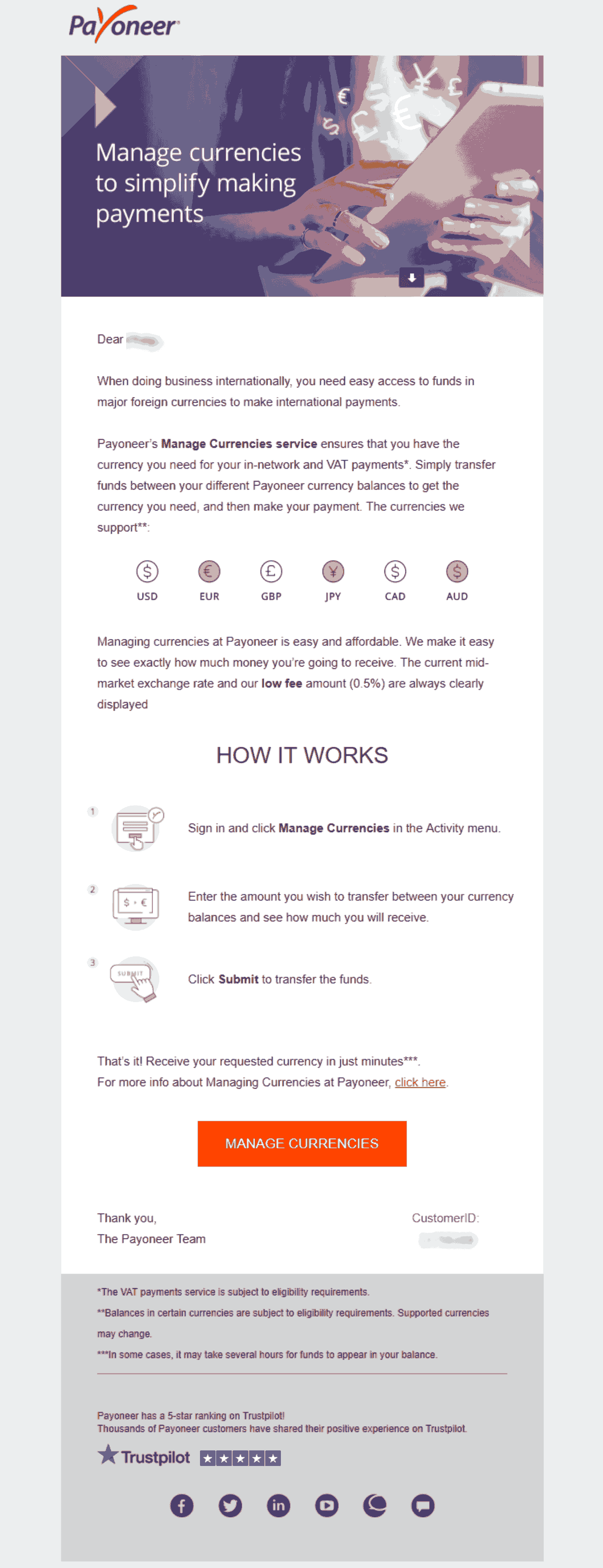
Emails like these can enhance user experience and increase product usage as well.
7. Freemium and free trial
Though this is not a product-led content marketing strategy, this tactic is indispensable for product-led growth marketing. You are putting all the time and effort into creating helpful product-led content that urges readers to use the product. But why would a prospect want to invest their money in a product only because you claim it solves their problem? Customers today look for self-serve solutions. They don’t want to talk to a sales rep, but rather to use the product and get a hands-on experience before stepping into the buying process.
This is where having a freemium or a free trial model helps immensely. Most SaaS products today have a freemium plan that offers some of the basic features at zero cost. Anyone can sign up with just their email address and start using the free plan. However, most of the advanced features are included only in the paid plans. So if a user on the freemium plan finds the product really useful, they may be willing to pay for more of it. This gives you product-qualified leads to pursue.
Some SaaS products offer a free trial for 15 days or a month, instead of a freemium. The idea behind this is the same.
When you club your product-led growth strategy with a freemium or a free trial, you are increasing your chances of converting these product-qualified leads.
8. Offer incentives and referral points
Many SaaS products incentivize users for sharing and referring the product to their friends and colleagues. Most of the popular SaaS platforms including Trello, Airtable, and Notion have their own referral programs. With these, you get either a discount, an extended free plan, or a free premium subscription for a limited period if you share the product with a friend.
Here’s an example from social media management tool Postcron’s referral program, which offers you one free month in exchange for a referral.
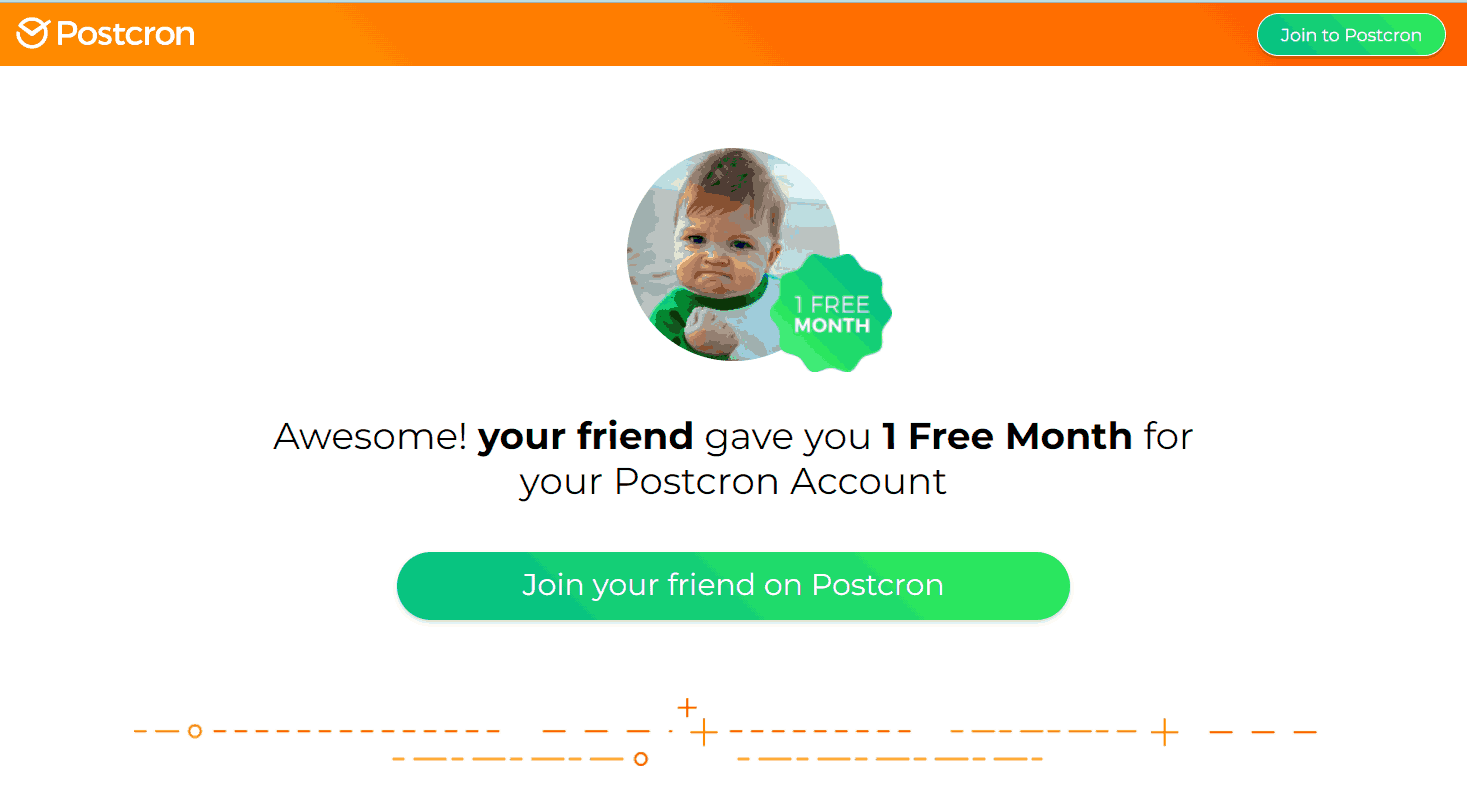
A powerful product, a solid product-led content strategy, and a lucrative referral program can make the customer-acquisition process so much smoother.
Summing up
With product-led marketing, the role of marketers becomes a lot more diversified. Product managers, sales teams and customer success also have a lot to contribute in the growth marketing efforts. Effective collaboration between these different teams and a strong product-led marketing strategy can do wonders for your business, driving marketing-led growth for your business. With these few product-led content marketing tactics, you should be able to create a fail-proof framework.


